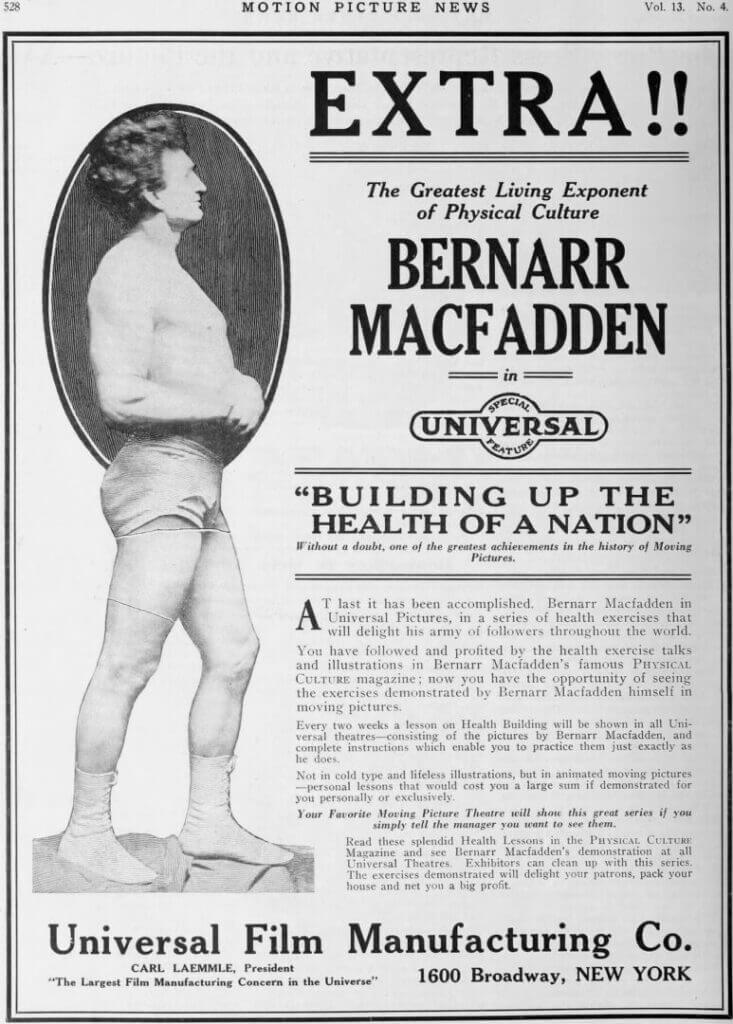Here are the top 3 fitness marketing tactics that have stood the test of time.
I am proud to report that Gym World is now considered academic literature.
This week we found out that Dr. Conor Heffernan, a lecturer in Sociology of Sport at Ulster University, assigns his students episodes of Gym World.
To honor this landmark achievement, today we’re talking about the history of the fitness business.
In my talk at the Two-Brain Summit, I drove home a lesson from old copywriting books:
Human nature doesn’t change, and neither do the laws of marketing.
Just look at these old headlines:

They’re incredibly similar to the ones used by most gyms that advertise a 6-week challenge.

Fitness marketing hasn’t changed much over the last century, and I asked Dr. Heffernan to do a guest post and prove it to you.
Professor, take it away.
Look better naked, move better, eat better… be better. Fitness marketing takes many forms but, as the history of fitness proves time and time again, the underlying principles in selling fitness have remained relatively static for over a century.
As a historian of strength, one of the most amusing things about the fitness industry is how the same messages are repackaged again and again but always with the promise that this time, it’s different.
Despite what your favorite Facebook marketing guru tells you, there’s nothing new under the sun when it comes to fitness, and the reality is we often use the same approaches and campaigns as people forty or fifty… or even one hundred years ago.
Here, I’m going to explore three fitness tropes which continue to hold sway with prospective clients.
1. The Before and After Image
Have a photo of a client or trainer before they began exercising or taking a supplement, put it side-by-side with their transformed body.
This is the kind of content that TikTok and Instagram thrive on.
What most people don’t realise is that the first before/after images were taken in the 1850s! At that time, a British physical educationalist Archibald Maclaren was attempting to revolutionise military training programs. To convince the military that his system was effective, Maclaren took photos of trainees before and after his workout course, thereby showing increases in muscularity.

Source: Physical Culture Study
The second high profile example came in 1889 when an American trainer, ‘Professor’ David Dowd published Physical Culture. In it, Dowd used an illustration (not even a photo!) of his body before and after training. The effect was the same. It showed beyond doubt that his workout was effective. This practice continued throughout the twentieth century as entrepreneurs sought to sell books, equipment, memberships, and supplements.

Source: Physical Culture Study
The lesson here? People want to see to believe.
2. I Used to Be Like You … Only Worse!
In 1889, a Prussian strongman named Eugen Sandow came to fame when he defeated a fellow strongman, Cyclops, in a weightlifting competition.
From 1889 to 1914 Sandow became a global physique star and even hosted the world’s first bodybuilding competition in 1901. So influential was Sandow that the current trophy for the Mr. Olympia competition, bodybuilding’s premier show, is modelled on the trophies from Sandow’s 1901 competition.

Source: The History of the Mr. Olympia Sandow Trophy
In the 1890s, Sandow was advertised as the ‘World’s Most Perfectly Developed Man’ by Dudley Allen Sargent, a man who was measuring thousands of bodies at that time in the hope of discovering bodily perfection.
Sandow lifted heavy weights and was blessed with great genetics. In 1897, he published Strength and How to Obtain It where Sandow declared to have been sickly and weak as a child.
It was his patented training system (which you could buy for a reasonable price) which transformed his body.
Three decades later, in the 1930s, Charles Atlas produced the most influential fitness advertisement of all time with a similar message. Titled The Insult Which Made A Man Out of Mac, the advertisement followed a similar pattern. A previously weak boy was made incredibly strong thanks to Atlas’ system.

Source: Hogan’s Alley
Earlier this week on Facebook, I read a post about how sick, unwell, and tired someone was before they took up a new workout course. It ended, predictably, with an invitation to buy a workout course from them.
Much like the before/after shots, people clearly need to buy into a narrative that transformation is possible before spending money. Some, like Sandow, bend the truth somewhat, but the desire is there.
JF note: KneesOverToesGuy is making millions using this angle.
3. Better Than Medicine… or Steroids!
From the late 1880s, when our current health and fitness world began, to the 1950s, many supplements and workouts were sold as better than traditional medicine.
Bernarr Macfadden, a man who once ran America’s biggest fitness empire, even went so far as to claim that his diets and workouts could cure things like cancers and liver disorders. He was also the same man who believed baldness could be cured by pulling violently on your hair, so take his advice with a pinch of salt. Likewise, Sandow opened a Curative Institute of Physical Culture where he, too, claimed to cure cancers with exercise alone.

While we still see unscrupulous entrepreneurs claiming to cure serious medical conditions with specialised diets and exercise, a far more common tactic nowadays is to promise steroid-like results.
This began in the late 1950s and early 1960s, when American doctor, and medic for the US Olympic Weightlifting team, Dr. John Ziegler, introduced Dianabol to American weightlifting. Dianabol was the first steroid used in America and, crucially, it came to the attention of Bob Hoffman.
Then coach for the US weightlifting team, Hoffman also ran York Barbell which was America’s biggest barbell and supplement manufacturer at that time. Hoffman began to sell supplements and workout courses with images of athletes who were using steroids. Ignoring, totally, the use of steroids, Hoffman instead claimed that his supplements or routines could add 50, 60, or 100 lbs. to one’s lifts, or 30 lbs. of muscle mass fast! He was not alone; from the 1960s to the present day, fitness advertisements consistently use steroid-using athletes to sell products.
It continues in an online age where websites and forums are used to distinguish between natural and enhanced athletes and influencers. Another variation of this approach is to see products sold which explicitly promise steroid-like results or make claims which could only be possible with chemical enhancement.

Such messages pry on people’s ignorance about what is possible for their bodies naturally or otherwise, but remain some of the most effective.
JF note: Liver King made millions with this approach until the public discovered that $11k/mo in steroids helped build his extreme physique.
Final takeaway
Connecting these three points together brings me back to a simple take-away – fitness is simple (but not always easy to sell).
People want to believe that transformation is possible. This transformation can be fantastical, such as when I bought creatine hoping to look like Ronnie Coleman, or realistic, as happened when I got a coach to help me break some deadlift plateaus.
The job of entrepreneurs is to create that image for people to latch on to, in order to buy their products. No matter how creative or original the message might be, the core tenets have remained unshakeable.
Dr. Conor Heffernan on Gym World
If you’d like to get a Ph.D. in the history of fitness marketing, check out Dr. Conor Heffernan’s full interview on Gym World.
It’s also available on Spotify and Apple.
To learn more about Conor, subscribe to his blog Physical Culture Study.
Cheers,
j






